Common menu bar links
Institutional links
Diseases & Conditions
Health & Safety
Research & Statistics
Agency Information
Search Box
E-mail this page
HIV in Canada Among Persons from Countries where HIV is Endemic
Centre for Infectious Disease Prevention and Control |
 |
HIV and AIDS Surveillance Data
The proportion of HIV test reports attributed to the HIV-endemic exposure category is on the rise
From 1998 to 2004, 15,876 positive HIV test reports and 2,989 AIDS cases among persons age 15 years and over were reported to CIDPC. Table 1 summarizes HIV and AIDS surveillance data for the Heterosexual Contact exposure category for positive HIV test reports and AIDS cases with exposure category information during the years 1998 - 2004. Of these reports, the HIVendemic exposure subcategory amounted to 467 positive HIV test reports and 340 AIDS cases, accounting for 5.6% and 12.7% of reports with exposure category information, respectively.
Table 1. Proportion and Number of Cases from the Heterosexual Exposure Category from 1998 to 2004
| Positive HIV Test Reports (n= 8,324*) |
AIDS Cases (n= 2,669*) |
||||
| Exposure Category | Percent (Number) | Percent (Number) | |||
| Heterosexual Contact | 29.7% |
(2,468) |
29.1% |
(776) |
|
| HIV-endemic | 5.6% |
(467) |
12.7% |
(340) |
|
| HET-RISK | 14.1% |
(1,176) |
7.2% |
(191) |
|
| NIR-HET | 9.9% |
(825) |
9.2% |
(245) |
|
| * n = number of cases with available information on exposure categories | |||||
For HIV surveillance data, the absolute number of positive test reports in the HIV-endemic exposure subcategory increased from 34 positive test reports in 1998 to 98 in 2004 (Figure 1). The proportion of overall positive test reports attributed to the HIV-endemic category increased from 2.8% in 1998 to 7.8% in 2004.
Figure 1. Number of Positive HIV Test Reports Attributed to the HIV-endemic Exposure Subcategory and Proportion of all HIV Positive Test Reports by Year (1998-2004)
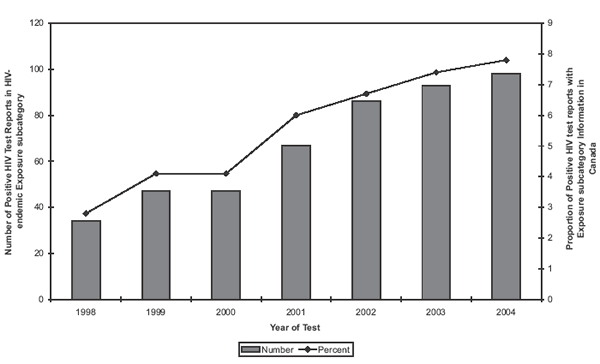
Although the absolute number of AIDS cases attributed to the HIV-endemic exposure category has decreased over time (from 58 in 1998 to 30 in 2004), the proportion of overall AIDS cases attributed to the HIV-endemic exposure category has increased from 9.6% in 1998 to 15.9% in 2004 (Figure 2).
The increases in positive HIV test reports observed within the HIV-endemic exposure category could be due to a true increase in new infections among individuals born in HIV-endemic countries, better reporting for the HIV-endemic exposure category by the provinces and territories, or increased HIV testing in this population. Increased testing is at least partly responsible for this increase due to the recent policy of Citizenship and Immigration Canada (CIC) whereby immigrants and refugees are tested for HIV for purposes of counselling (refer to the section entitled: 'Immigration and HIV/AIDS Surveillance'). In fact, similar trends have been observed in other countries with large numbers of immigrants born in countries where HIV is endemic (such as the United Kingdom).14 Data from 12 countries in the European HIV surveillance network suggest that between 1997 and 2002 there was an increase in the number of cases diagnosed in people originating in countries with generalized HIV epidemics, (an increase of 179% from 1382 to 3861 diagnosed cases).15 The trends were largely driven by the UK, which accounted for 30% of the population and about 40% of the HIV diagnosis reported in the 12 countries in that time period. It is not a surprise that the UK accounts for a large proportion of HIV diagnosis since that country has a large population born in HIV-endemic countries.14,16,17
A substantial proportion of positive HIV test reports and AIDS cases in the HIV-endemic exposure category occur in younger age groups
When the HIV-endemic exposure subcategory is broken down by age, some important findings emerge. Among positive HIV test reports attributed to this subcategory, 80% of reports occurred in those aged less than 40 years (34.2% among those < 30 years and 45.8% among those aged 30 - 39). For AIDS cases attributed to the HIV-endemic exposure subcategory, almost half of the cases (45.9%) were between the ages of 30 and 39. Another 14.4% were attributed to persons under the age of 30. Together, these two age groups account for two thirds (60.3%) of AIDS cases within the HIV-endemic exposure category.
Figure 2. Number of Reported AIDS Cases Attributed to the HIV-endemic Exposure Subcategory and Proportion of all AIDS Cases by Year (1998-2004)
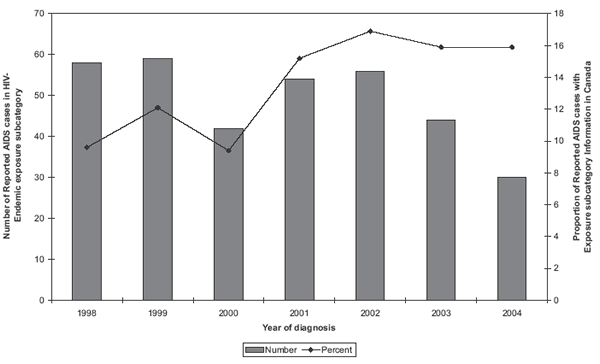
When compared to other subcategories within the larger heterosexual contact exposure category, the greatest contrast in age distribution is for AIDS (Figure 3). Within the HIV-endemic exposure subcategory, those ≤ 39 years old accounted for 60.4% of cases compared to 41.9% of cases in the category of sexual contact with a person at risk and 44.5% in the NIR-HET category.
A similar trend can be seen for positive HIV test reports: a substantial number of positive HIV test reports within the HIV-endemic exposure subcategory occurred in younger age groups when compared to other subcategories within the Heterosexual Contact exposure category. Figure 4 shows that 80% of positive HIV test reports in the HIV-endemic exposure category occurred among those ≤ 39 years old. Within other exposure categories, this age group accounted for 60% of test reports among those who reported sexual contact with a person at risk, and 73.7% of test reports in the NIR-HET exposure category.
Figure 3. Age Distribution of AIDS Cases Among the Heterosexual Contact Exposure Subcategories: 1998-2004
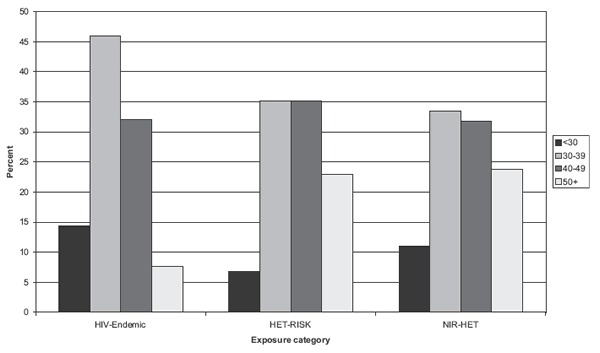
Figure 4. Age Distribution of Positive HIV Test Reports Among the Heterosexual Contact Exposure Subcategories: 1998-2004

The large proportion of positive HIV test reports among younger age groups within the HIV-endemic exposure subcategory suggests that compared to others infected through heterosexual contact, persons in the HIV-endemic exposure category are infected at a younger age. These findings can act as early warnings for public health practice since they indicate that HIV prevention and control programs could be more effective if targeted to a younger audience.
Ethnicity within the HIV-endemic exposure subcategory
Of the 247 positive HIV test reports belonging to HIV-endemic exposure subcategory with information on ethnicity, 90.3% identified themselves as 'Black', 4.9% as 'Asian', 2.8% as 'Other', and 2% as 'White'. Among similarly defined AIDS cases, 87.4% identified themselves as 'Black', 7.1% as 'Asian', 3.4% as 'Other', and 2% as 'White'.
Two of Canada's largest provinces, Ontario and Quebec, do not provide ethnic information on positive HIV test reports to the national level. This is a limitation for monitoring the epidemic among persons from countries where HIV is endemic as these two provinces together account for over two-thirds of all positive HIV test reports. These two provinces also include two large urban centres, namely Toronto and Montréal, which contain large proportions of people from countries where HIV is endemic.
Women Represent Over Half of those in the HIV-endemic exposure category
Between 1998 and 2004, women accounted for 239 positive HIV test reports and 143 AIDS cases within the HIV-endemic exposure subcategory. Figure 5 demonstrates the proportion of positive HIV test reports and AIDS cases accounted for by women in the Heterosexual contact subcategories.
Among positive HIV test reports, women accounted for 51.6% of all positive tests attributed to the HIV-endemic exposure category. For the other heterosexual contact subcategories, women also accounted for a substantial proportion of cases: 44.4% of the sexual contact with a person at risk subcategory and 40.4% of the NIR-HET subcategory. For AIDS surveillance data, women accounted for 41.9% of AIDS case reports within the HIV-endemic exposure subcategory, compared to 44.0% and 23.7%, respectively, of the sexual contact with person at risk and NIR-HET categories. However, these data are based on small numbers.
Figure 5. Proportion of Positive HIV Tests Reports and AIDS Cases Attributed to Females for the Heterosexual Contact Exposure Subcategories: 1998-2004
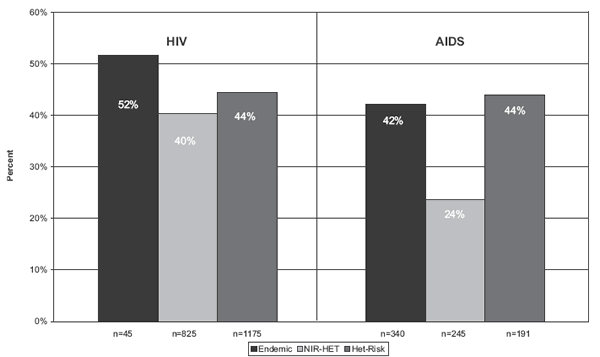
As discussed in the introduction, there are a number of health determinants (such as poverty) that influence vulnerability to HIV infection and access to services within the community. While women from countries where HIV is endemic are affected by many of these determinants, it has been proposed that certain subpopulations (such as women and refugees) are especially marginalized and made more affected by these barriers.18
Women of Childbearing Age and Perinatal Transmission
Since women account for a substantial number of positive HIV-test reports within the HIV-endemic exposure subcategory, and since the HIV epidemic appears to be affecting younger persons within this subcategory, it is important to consider women of childbearing age (ages 15 to 44) and the potential for perinatal HIV transmission. Each year a number of infants are perinatally exposed to HIV due to the positive HIV status of their mothers. The Canadian Perinatal HIV Surveillance Program collects data on the HIV status of such infants through a national, non-nominal confidential survey on infants known to pediatricians in tertiary care centers and HIV specialists in clinics across Canada. The Canadian Pediatric AIDS Research Group (CPARG) conducts surveillance on such exposures, access to preventive treatment, and actual infections that occur following exposure.
Figure 6 summarizes maternal country of birth data for infants in Canada who were perinatally exposed to HIV and for whom the maternal exposure category was heterosexual contact. Prior to 1998, three regions accounted for approximately 90% of exposures: North American-born mothers accounted for 31% of exposures, followed by Caribbean-born mothers at 31% and African-born mothers at 28%. By 2004, there were increases in the proportion of exposures attributed to North American and Africanborn mothers, accounting for 47% and 42% respectively. The proportion of exposure attributed to Caribbean-born mothers decreased to 5% of all exposures.
When interpreting these data, it is important to note the data presented in this section are based on infants born to women who were known to be HIV positive. The numbers presented do not reflect all infants perinatally exposed to HIV infection, as not all pregnant women are aware of their HIV status. Also, the region of birth data presented by CPARG does not break out the sub-Saharan regions of Africa.
Although all provinces and territories in Canada promote voluntary HIV testing of pregnant women and women considering pregnancy, there is variation in how this policy is implemented across jurisdictions. For more information on perinatal transmission, refer to the Epi Update entitled "Perinatal Transmission of HIV".19
HIV-1 Strains
The Surveillance and Risk Assessment Division (SRAD) recently released a report on the distribution of HIV-1 strains based on 1,994 samples that were collected between the years 1986 and 2004.20 Overall, the vast majority of positive samples were of the B group HIV-1 strain as compared with the non-B group HIV-1 strain (89% and 11% respectively). However, the HIV-endemic exposure subcategory accounted for the highest proportion of non-B group HIV-1 at 82.2% of tests in this exposure category.
Figure 6. Maternal Heterosexual Exposure Category by Region of Birth for Perinatally HIV-exposed Infants Canada 1984-2004
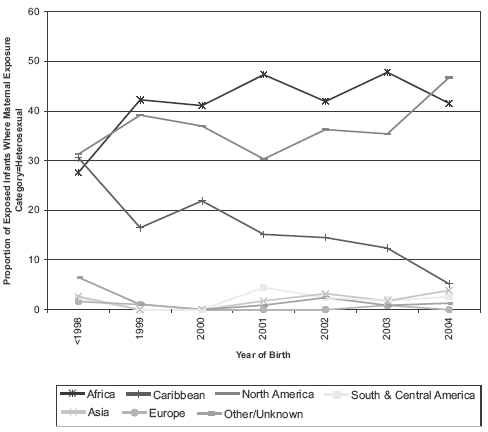
The high concentration of non-B group HIV-1 strains in the HIV-endemic exposure subcategory has been supported by an Ontario study by Njihia21 and colleagues that used some of the data from the SRAD. These data were based on samples collected between October 2003 and October 2004. The HIV-endemic category had the highest proportion of non-B group strain with 77.3% of the samples (17 out of 22 samples) with this strain. The researchers also looked at the distribution of strains by region of birth and found that 91.5% of positive persons born in North America had B group HIV-1, compared with 86.7% of persons born in Sub-Saharan Africa with non-B group. Clearly, strain type is related to country of birth which in turn is related to the fact that non-B strains predominate in Africa and other regions of the world outside of North America, Europe and Australia/New Zealand.
The observed difference in strains between the HIV-endemic category and all other exposure categories has public health implications for the prevention, detection and treatment of HIV/AIDS. As the diversity of HIV-subtypes continues to shift, it will invariably create a public health challenge to ensure existing diagnostic tests detect all subtypes, including the various non-B strains. In addition, information on strain type will help direct future vaccine development and will help assess the utility of any future vaccine for the specific situation found in Canada.22

